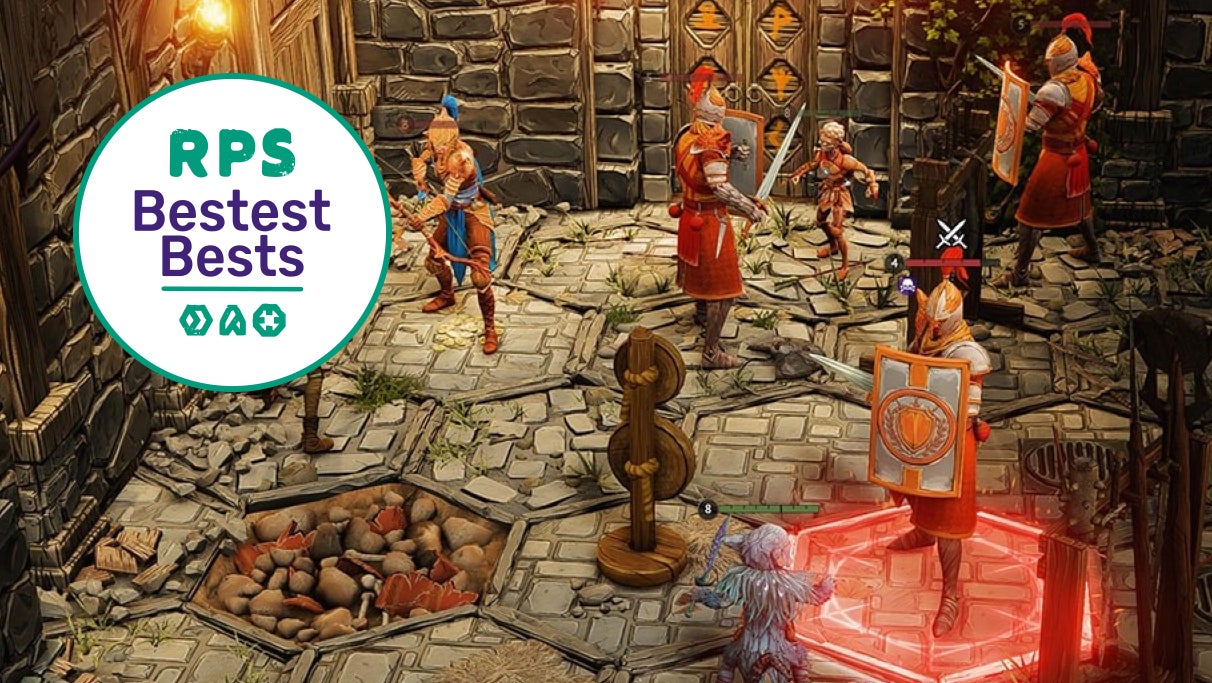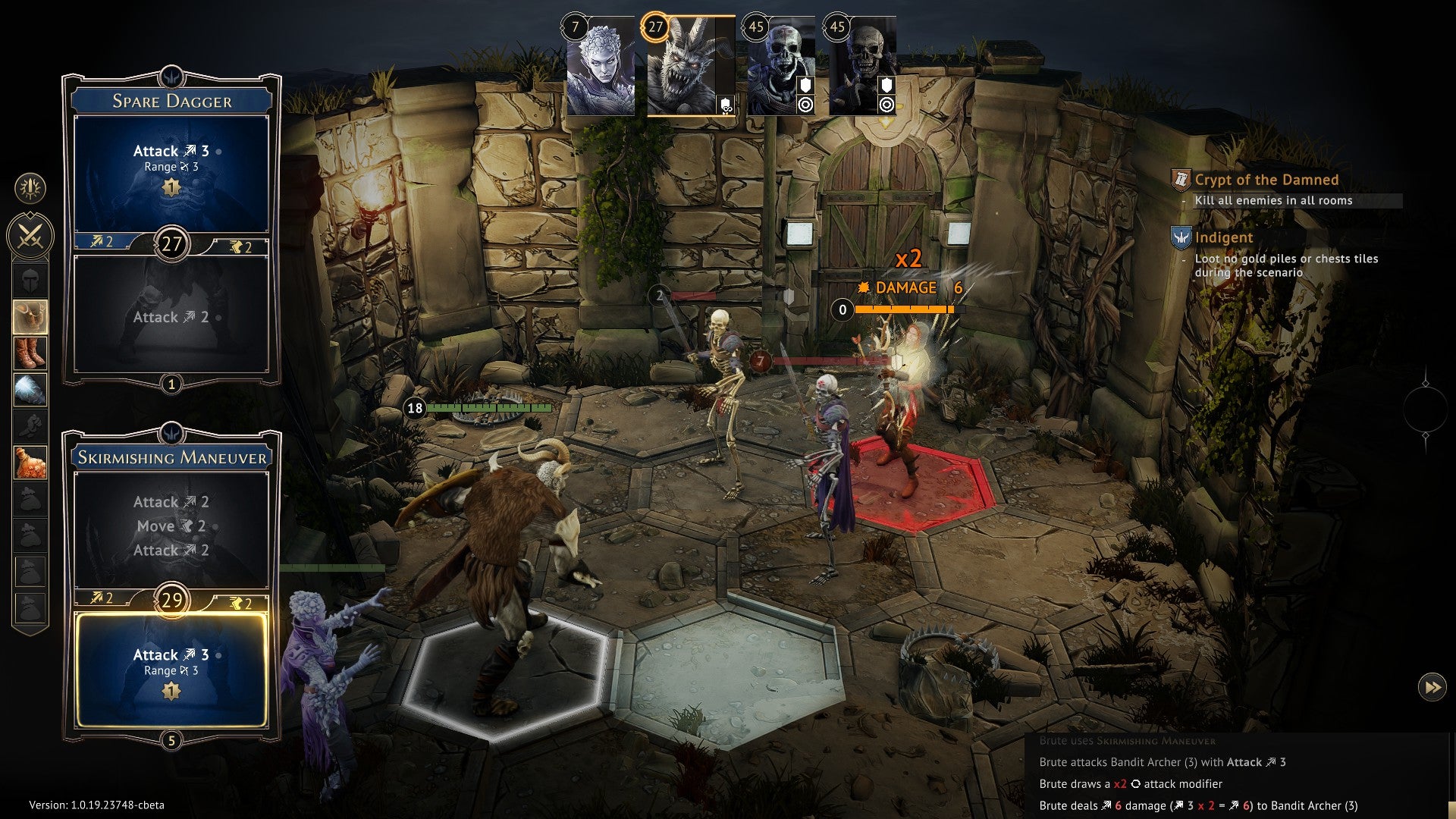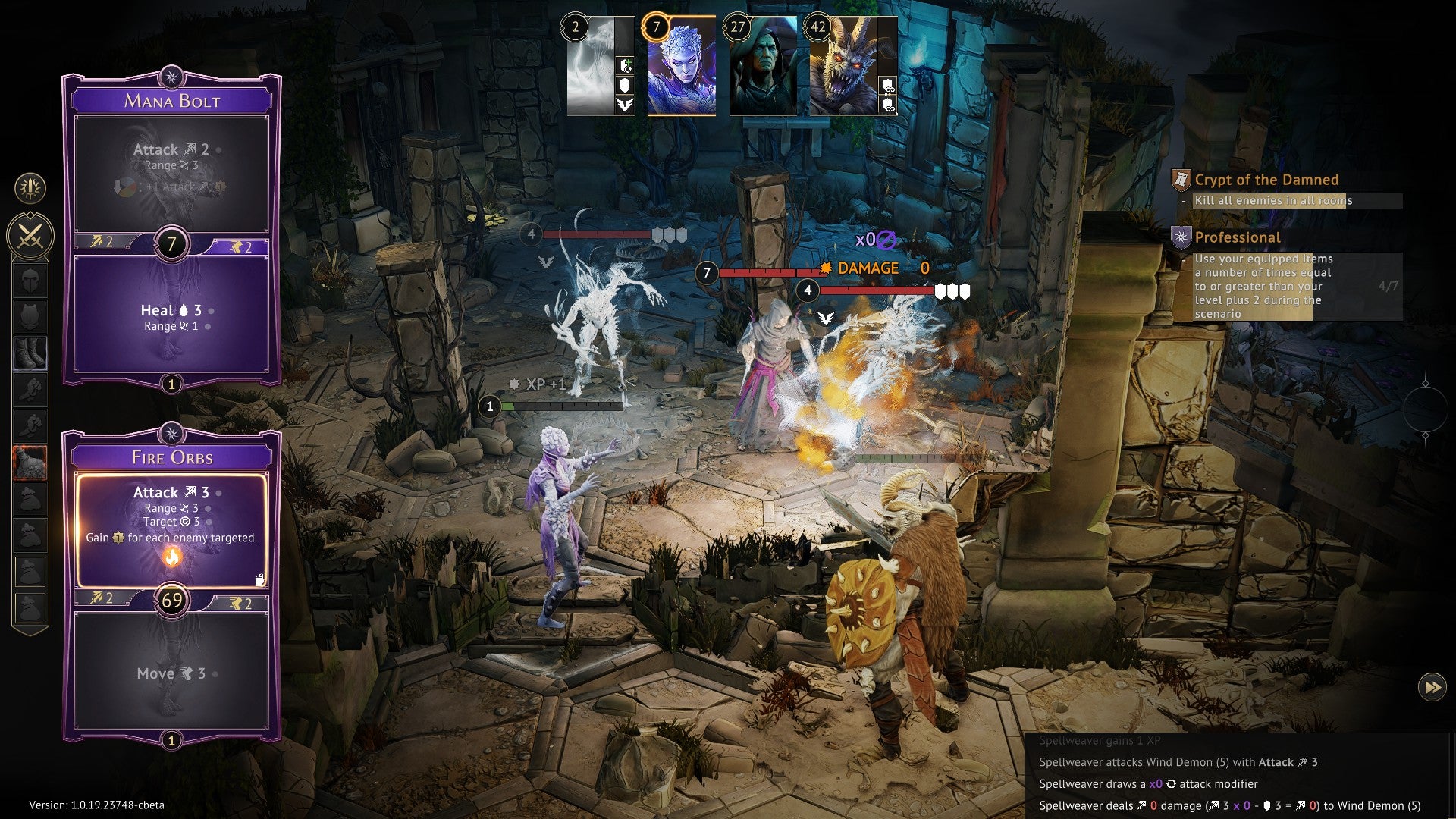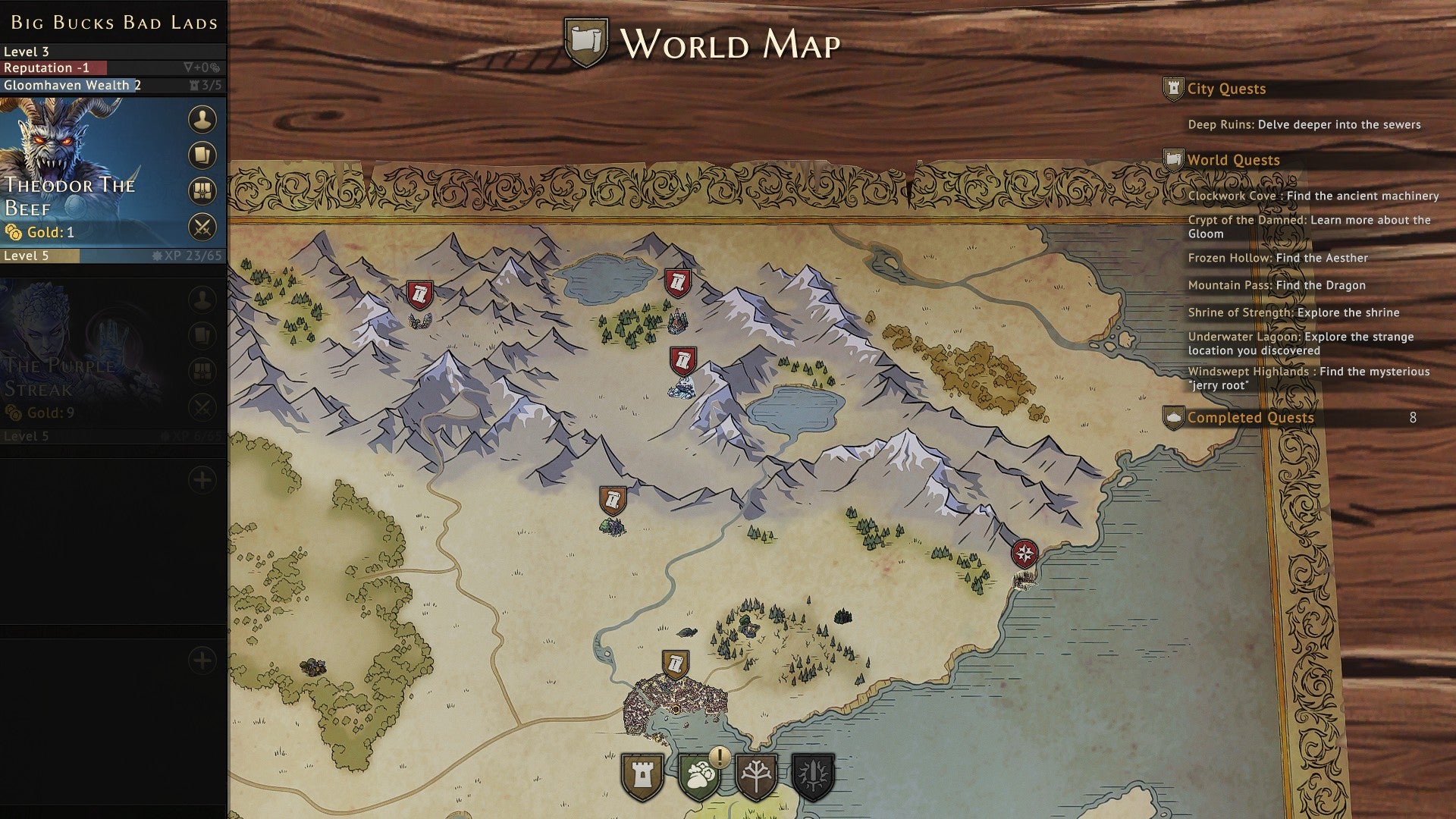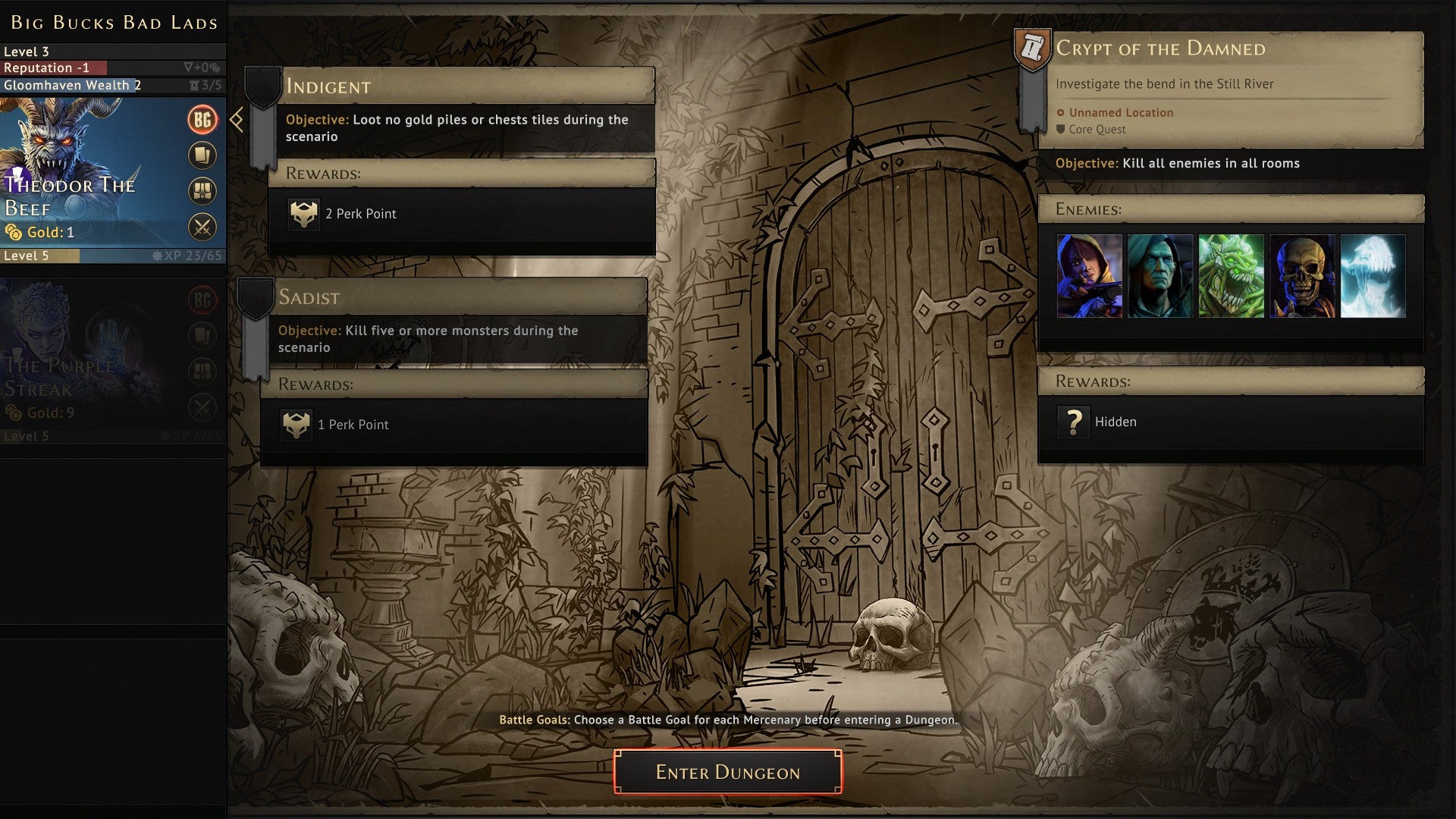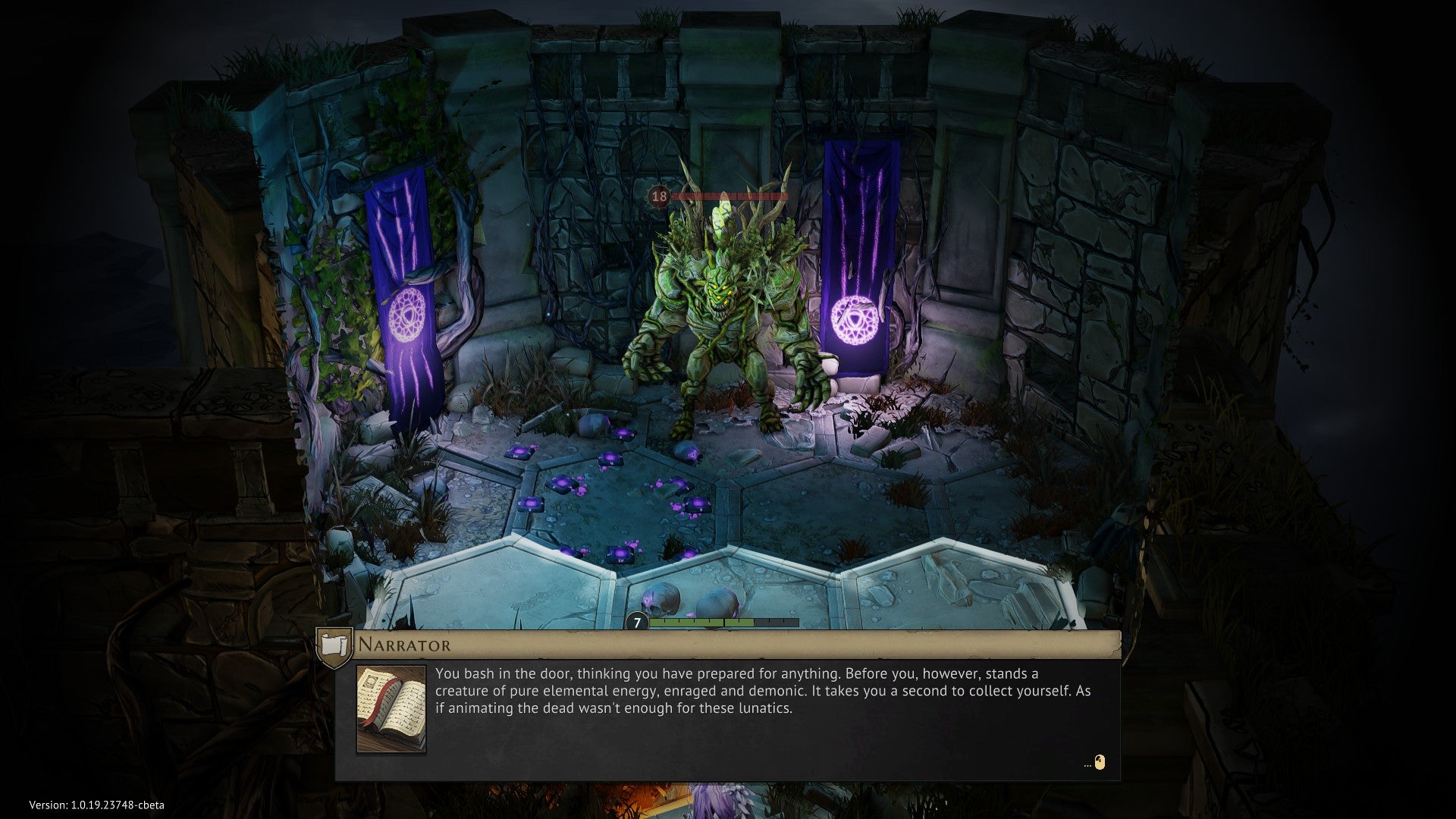-
Welcome to rpgcodex.net, a site dedicated to discussing computer based role-playing games in a free and open fashion. We're less strict than other forums, but please refer to the rules.
"This message is awaiting moderator approval": All new users must pass through our moderation queue before they will be able to post normally. Until your account has "passed" your posts will only be visible to yourself (and moderators) until they are approved. Give us a week to get around to approving / deleting / ignoring your mundane opinion on crap before hassling us about it. Once you have passed the moderation period (think of it as a test), you will be able to post normally, just like all the other retards.
You are using an out of date browser. It may not display this or other websites correctly.
You should upgrade or use an alternative browser.
You should upgrade or use an alternative browser.
Gloomhaven - roguelike dungeon-crawling adaptation of the board game
- Thread starter LESS T_T
- Start date
dacencora
Guest
I didn’t much care for FG2. It’s possible that the other campaigns/expansions are better but the base game is boring as hell. The first game had much better unit variety and flavor, not to mention, more than one General at launch. I feel that they wasted so much effort and time on the lackluster story, when they could have taken the pretty decent engine and made interesting fights and scenarios.actually excellent games like Fantasy General 2
Red Hexapus
Savant
Screw the PC version, get that 10 kg box of carton.
Its worth every penny (and as far as I understand, the scenarios in video game adaptation are different, and thus not made by Isaac Childres)
Having completed 1.8 campaigns (one full, one almost full) I'm going to disagree with that statement. The board game is great from the tactical point of view, especially with 3-4 players. However I need to say that I think this game should have been a computer game from the start, because of a lot of tedious stuff that takes a lot of time and can be cut down by the computer (setup + cleanup of scenarios, enemy AI, enemy and character HP and attack calculations, adding new enemies during the game etc.). Not even talking about apps that you need to keep track of the state of the game (GH Campaign Tracker + GH Helper).
This reminds me of another board game that greatly benefitted from the transition to a computer format. "Civilization: Through the Ages", I would never play it again it takes too fucking long to take care of all the tedious stuff, especially with 4 players. Digital version cuts down on the time by at least 2 hours by shifting these tedious cleanup and calculation on the computer.
So what I would like to say I guess is: go for the digital version and dig your teeth into the meat of the game, omitting the less tasty parts.
You can solo the tabletop version
Still, where Gloomhaven shines is party play, and I suspect it might get stale fast without other people.
Sure, I played my share of Arkham Horror. It's p. fun to play solo but nothing can beat a 4-man team, drinking, smoking stogies and narrating dramatically the slow train crash most games inevitably degenerate into.
v1rus
Arcane
- Joined
- Jul 14, 2008
- Messages
- 2,309
You can solo the tabletop version
Still, where Gloomhaven shines is party play, and I suspect it might get stale fast without other people.
Sure, I played my share of Arkham Horror. It's p. fun to play solo but nothing can beat a 4-man team, drinking, smoking stogies and narrating dramatically the slow train crash most games inevitably degenerate into.
I've been wanting to give Arkham Horror a try for a long, long while. But its quite messy, with all those different versions (I really cant differ Arkham Horror from Mansions of Madness or Eldritch Horror, its all a yuge Lovecraftian blob to me) and most importantly, FFGs extremely predatory DLC shit, it feels like a true pain in the ass to get going, no matter how awesome it sounds.
When it comes to Gloomhaven, its pricey as all fuck, but thats it. No missable promos, no thousand litttle expansions. You get the big box, and almost everything. You can buy the single expansion, download the free solo scenarios, and all done.
That all aside, as I've previously mentioned - I find the goal design to be one of the smartest design choices in the game. I've actually been playing big box version for only a couple of sessions, so I cant say much, but we beat every single JotL scenario, on +2 (very hard), and still goal design is bri-lli-ant.
Basically, theres a deck of goal cards, that gets shuffled between every scenario. Before beginning the scenario, you shuffle the deck of cards, and deal two goals to each player, and every player chooses one to keep other to discard. The goals must (and really should) be kept secret - if you complete the goal (never fall past half hp, end the scenario with only a single hp, have the most treasure, etc.), and win the scenario, you get a perk.
I cant begin to describe how much this changes the game. Everyone is going to jeopardize the mission so he can get his goddamn perk, everyone. And if the mission is failed, you dont get a perk even if you completed the goal. The kind of cognitive dissonance it creates, is amazing. I once spent 20 minutes throwing a honest to god tantrum on my teammate (and dear friend) for compromising the mission so he would complete his goddamn battle goal, only to realize that I was doing the exact same thing. And, honest to god, I wasnt even realizing what I was doing. My goal just had to be completed. The other time, another party member also comprised the mission to do his stupid battle goal - except he didnt realize, until half the mission that he had already unlocked all his perks. He knew that ofc, we commented on it before the scenario started, but it just didnt click for him - because you have to do your goddamn goal.
Its an amazing piece of design really, and truly changes how the game is perceived and played, adding a whole another layer behind party tactics optimization.
Personal goals are just like battle goals, except they are only found in big box Gloomhaven, and span your characters entire career. As I said we just started the big box, so I cant comment on them much, but the basic design principle is same.
I've been wanting to give Arkham Horror a try for a long, long while. But its quite messy, with all those different versions (I really cant differ Arkham Horror from Mansions of Madness or Eldritch Horror, its all a yuge Lovecraftian blob to me) and most importantly, FFGs extremely predatory DLC shit, it feels like a true pain in the ass to get going, no matter how awesome it sounds.
Oh yeah, FFG gonna FFG. The important thing to know about AH is "get the 2nd edition!1!". Throw in a few expansions if you can get them for a reasonable price but the base game is more than good enough. You can only get it on BGG or eBay nowadays coz FFG has a 3rd edition out now but it's shit - streamlined, dumbified, a decline. Arkham Horror is supposed to be baroque, atmospheric, complex, wonderfully bloated, just like the Lovecraft mythos itself. People who can't deal with it should stay away.
Red Hexapus
Savant
The best Arkham Horror nowadays is the Living Card Game. It is pricey as fuck and the original 3-scenario campaign (The Night of the Zealot) doesn't leave a very good impression, but it's only incline with the other campaigns. The Path to Carcosa is awesome, highly recommend to try it (via OCTGN or TTS). Thinking about it, it would have been great if they made a digital version, instead of the Mother's Embrace disappointment.
Yeah I value my hard earned money too much to get into any CCG or LCG ever. But I could check some mods for TTS, true. Hopefully playing a card game in TTS is a bit more practical than AH itself.The best Arkham Horror nowadays is the Living Card Game. It is pricey as fuck and the original 3-scenario campaign (The Night of the Zealot) doesn't leave a very good impression, but it's only incline with the other campaigns. The Path to Carcosa is awesome, highly recommend to try it (via OCTGN or TTS). Thinking about it, it would have been great if they made a digital version, instead of the Mother's Embrace disappointment.
Also absolutely, they should've made a digital AH long ago, instead of aggressively policing and taking down TTS mods.
Lacrymas
Arcane
- Joined
- Sep 23, 2015
- Messages
- 19,120

There is no exploration per se, all the battles take place in a self-contained map. The combat is great, pure incline, the only thing that bothers me is the RNG when it comes to damage, but you'll get over it. Guildmaster is just another campaign. The difference is that the missions are different and the maps for these missions are randomly generated (the missions and their objectives are static) and it has less of a narrative. At least that's what I think, if someone else knows any other differences, please share them.Can someone share impressions about combat/exploration in early access?
Also what are two modes, exactly? One is being "Guildmaster"?
Red Hexapus
Savant
The system is a carbon copy of the board game. There is no exploration, unless you consider road and city event cards before missions as such. Combat is card-based, where you pick two cards and perform the actions printed of them. You start losing the cards during each scenario, and if you lose them all you're out. That's about that.
The main mode should be the Campaign. Guildmaster is like a quasi-campaign, without the character personal goals, world achievements and stuff. Gameplay is the same, it is just organized differently.
Here's the super-quick introduction to the board game, video game is the same (mostly).
The main mode should be the Campaign. Guildmaster is like a quasi-campaign, without the character personal goals, world achievements and stuff. Gameplay is the same, it is just organized differently.
Here's the super-quick introduction to the board game, video game is the same (mostly).
- Joined
- Jan 28, 2011
- Messages
- 100,694















Coming to GOG: https://af.gog.com/game/gloomhaven?as=1649904300
Last edited by a moderator:
- Joined
- Jan 28, 2011
- Messages
- 100,694















https://www.rockpapershotgun.com/gloomhaven-pc-review
Gloomhaven review: a loving adaptation that nails the ambition and detail of the tabletop original
Clear the decks
Gloomhaven’s scoundrel has a custom animation for her flintlock pistol, and I am still jazzed about it. Releasing today in full after lurking in early access for the last two years, there are 17 classes in this digital adaptation of Cephalofair’s tabletop legacy dungeon crawler, hereafter referred to as ‘Tablehaven’. Each class, from psychic rodent Mindthief to basalt shithouse Cragheart, has around 30 ability cards each. And Flaming Fowl, alongside offering Tablehaven’s entire branching campaign, map editors, and a digi-only ‘Guildmaster’ campaign, have animated this single flintlock shot. It’s almost opulent.
All right, so I probably won’t use it much. Five damage at range four is a belter, but that burn hurts for a single target ability. I’ll be smiling when I do, though. Grinning as the scoundrel whips the silver pistol from her hip and deletes a cultist just before he summons a skeleton. Just as I’ve been grinning at these detailed, cel-shaded dungeons and grimy sewers, or the spoken narration before each quest. All Gloomhaven needed to do was not get in Tablehaven’s way too much. Accuracy and usability would have been just fine. But there’s enough passion and pizzaz in this wonderful package that a part of me wishes I was new here, just so I could be surprised all over again.
The game can’t recreate all Tablehaven’s magic, but it would be silly to expect it to. Shuffling cards and shifting tactile plastic goblins. Sharing crisps with table pals. Maybe you occasionally offer crisps to plastic goblins, smiling as you crush the rim of a salt n’ vinegar Disco against tiny Mr. Shanksworth’s unshifting grimace. No judgement here, friend.
It works both ways, though. Every time I click ‘exit game’ and watch Gloomhaven deconstruct itself in seconds, I sit back and mentally mock my past self as he laboriously sorts tokens into little trays. I bought those trays, and I had to glue them together. I can’t guarantee much in these tumultuous times, but I can swear to you that digital Gloomhaven will never require glue in any capacity.
Here’s how events unfold down Gloomhaven way. First, you pick your mercenaries from the six available starting classes. Not heroes, mind. Mercs. Later, you may defend the city against encroaching undead. You may just decide to pilfer everyone’s silverware while they’re distracted. So, select your average coin enjoyers. Two minimum, four maximum, solo or with up to three mates. Bring more mercs, face more monsters.
You buy some starting equipment, and pick retirement goals. Kill 20 different monster types, say. Or, complete a specific quest chain. Once a merc hits their goal, they’re off to the big table in the sky, but you’ll unlock a new class. One of them looks like a cauliflower wearing steampunk goggles.
Everything a merc does is controlled by a deck of cards, from moving and looting chests to commanding a pet bear to eat a ratman’s tiny ratshoes. Mercs play two cards per turn, selecting one action from the bottom of one card, and one from the top of the other. Each card has an initiative value from 1-99. Mercs lock in their initiative by choosing one of the two values before the turn starts, but they can still take their two actions in any order. As a broad generalisation, bottoms are usually movement or buffs, tops are attacks.
At the end of a turn, both cards you played are discarded. Can’t play two cards when your turn rolls around? You’re out. Ditto for running out of HP. The discard pile is not the end for these plucky information rectangles, however. Mercs can rest; burning one card to regain the rest of their discard pile. Gradually, more cards get burnt, and fewer become available. Burnt cards are, with some very rare exceptions, lost for the remainder of the dungeon. You’re effectively on a timer, so each decision feels monumental. You devise perfect moves to get the most value from each card, knowing wasted actions herald swift defeat.
Enemies are bound to similar rules. They each have their own initiative and AI patterns, which are revealed from their individual decks after you’ve chosen your cards. Happily, you're not locked into the order in which you play your cards, so there are still opportunities to react once you know what your foes are doing. These patterns repeat across enemy types - for example, all skeletons will move two hexes, then attack for that round - but they might do something different next round. And it might be proper evil, too.
There’s no dice involved throughout all this. Get back in your cage, you cuboid fiends. Shoo. Instead, Gloomhaven uses decks to modify damage. You might pull a crit (x2) or even utterly whiff it (x0), but it's mostly a bunch of +1s, -1s, and the like. Status effects like poison, stun, or immobilise always take effect, even when attacks do no damage. This pairs a handy, reliable layer of tactical certainty with the inherent drama of crits and misses.
Of course, there’s no easy way of adequately condensing 52 pages of rules in one review. So here’s a link to the one the game's designer made during the Kickstarter. Here’s a good video too. Immerse yourself in the delightfully meaty crunch of it all, like sticking your head in a big bag of Frazzles.
Between quests, you’ll return to the city of Gloomhaven and take part in city events. Now, arguing with a ratman about how much gold the hunk of metal he fished out of the toilet is worth might seem rather less thrilling than doing battle with skellies in a dungeon, but resolving these episodes still have their own unique charm. I reckon 80% of them involve something strange happening at the pub. You can also give some money from the church, who are surprisingly chill about accepting bags of blood-stained coins from big buff battle bastards, in exchange for crit-boosting blessings. You can hurt or help your reputation with the city. Eventually, you can cause the city to become more prosperous, unlocking new and exciting boots for sale, and giving a level boost to future mercs.
Complex? Yes. Complicated? Not especially, particularly with all the crunch automated. And while the same legacy tricks that are incredibly novel and exciting when pulled off by cards and stickers can seem a bit rote when performed by a digi-brain, Tablehaven’s procedural combat conundrums and tailored spatial puzzle dungeon design are just as captivating and satisfying here.
Gloomhaven can be tough as old ratshoes, mind. As a ruleset designed to reward a sizable time and social commitment with meaty challenges, it doesn’t necessarily facilitate casual play. It’s consistently demanding by the same virtue as it being consistently rewarding, but it does need your full attention. And ideally, the shared attention of some mates to tell you how crap your plans are.
I should add that you might occasionally encounter a bit of tiresome fantasy faff. ‘Barbaric tribes’, and so on. I’m not especially fond of this stuff. Neither is designer Isaac Childres. Nuance leads to more interesting world-building, and it’s heartening that stuffy writing from four years ago can already be considered a relic by its own creator.
Not everything here precisely replicates Tablehaven, either. Analogue enemy AI systems occasionally produce more than one valid move, allowing boardgamers to whiff ties in their favour, but here these are automated. Early on, you’re given a choice, with each of the three responses unlocking a different quest. Here, the game just unlocked all three quests for me. Whether this was a bug or a structural choice, I’m not sure.
Gripes aside, I love Digihaven for everything it does, and I love it even more because of how accessible and simple it makes such a magical tabletop experience. It’s not just a great tactics game in its own right, but a gateway to introduce the Monopoly-scarred to how nifty, gratifying, and ambitious the best digital board games have become over the last several years. Gloomhaven? Massive bloody grin-haven, more like.
Jack Of Owls
Arcane
I really don't like deck-buiding-based games - not that I've had a lot of experience with them - so while I was initially intrigued by this game, that's a deal-breaker for me.
Arbaces
Novice
- Joined
- Sep 11, 2021
- Messages
- 42
I wouldn't call Gloomhaven a deck building game in the same way as something like Hand of Fate or Slay the Spire because you don't draw random hands. The card pools are very small, and only around ten cards, varying by class, get taken into each mission. You select your "hand" of available actions as the last step before starting combat. When you use the actions they become unavailable until you rest, at which point one goes away for the rest of the fight and the others come back. Items work similarly, but they all refresh when you rest unless they go away when used. It is more of a resource management game than a deck builder.I really don't like deck-buiding-based games - not that I've had a lot of experience with them - so while I was initially intrigued by this game, that's a deal-breaker for me.
Okay I might have fed you one little white-lie: there is a deck you modify and randomly pull from, but it's only for random damage because rolling dice hurts eurogamers' dainty wrists.
Red Hexapus
Savant
My experience is based on the physical game, but but as mentioned by Arbaces it is not a deck builder. You select cards from the deck of the character before each mission and you try not to run out of them before it ends.
What's more I would say it is not a single player game, and two-player gameplay has some issues mostly with the higher difficulty of some retirement quest. The game shines at 3 and 4 player, when you have to communicate with the other players to defeat the enemies using your combined powers.
What's more I would say it is not a single player game, and two-player gameplay has some issues mostly with the higher difficulty of some retirement quest. The game shines at 3 and 4 player, when you have to communicate with the other players to defeat the enemies using your combined powers.
This is a great board game, but as others are saying, it's even better on PC. Feels like it was meant to be a video game from the start. So don't listen to the people telling you to buy the cardboard version. Buy Gloomhaven Digital and spend your cardboard money on something else. Not because it's a bad board game at all - it's fucking fantastic - it's just an even better video game.
holla_cabezas_de_mierda
Arcane
- Joined
- Jul 8, 2006
- Messages
- 3,082
the creator of the game is sorry about having racist orcs included in the game bTW..they won't be in Frosthaven I guess, he hir
If the goal is to generate a random number, then dice are superior to cards always, and I don't see how it could be any other way...some people (especially certain Euro Gamers it seems like maybe) don't understand RNG and simply have the reaction that any RNG with dice is 'bad' and not 'strategic' and means you are just relying on 'luck' or something.
These idiots make me rage and also are a cause of decline IMO, but I guess this has been talked about other places before...anyway the game looks nice, I can't decide if I would like it or not yet...
I never understand people who think cards replacing dice is somehow better when they are used as a way to generate a random number. Using a card is just a way to get a much less random number than using actual dice.I wouldn't call Gloomhaven a deck building game in the same way as something like Hand of Fate or Slay the Spire because you don't draw random hands. The card pools are very small, and only around ten cards, varying by class, get taken into each mission. You select your "hand" of available actions as the last step before starting combat. When you use the actions they become unavailable until you rest, at which point one goes away for the rest of the fight and the others come back. Items work similarly, but they all refresh when you rest unless they go away when used. It is more of a resource management game than a deck builder.I really don't like deck-buiding-based games - not that I've had a lot of experience with them - so while I was initially intrigued by this game, that's a deal-breaker for me.
Okay I might have fed you one little white-lie: there is a deck you modify and randomly pull from, but it's only for random damage because rolling dice hurts eurogamers' dainty wrists.
If the goal is to generate a random number, then dice are superior to cards always, and I don't see how it could be any other way...some people (especially certain Euro Gamers it seems like maybe) don't understand RNG and simply have the reaction that any RNG with dice is 'bad' and not 'strategic' and means you are just relying on 'luck' or something.
These idiots make me rage and also are a cause of decline IMO, but I guess this has been talked about other places before...anyway the game looks nice, I can't decide if I would like it or not yet...
- Joined
- Jun 7, 2012
- Messages
- 3,193
The point is that over the levels your rolling deck is tweaked according to your class. Thus, melee hitters end up with a bunch of +2/+3 or +1 Armor 2, while support classes get +1 DoT or +1 Heal cards. You can also permanently remove negative cards. So overall you can make your deck go from averaging +0 to averaging +2 or so. My high level Hatchett would always hit even if it was for 1 damage, for example, which was great for AoE abilities and debuffs.the creator of the game is sorry about having racist orcs included in the game bTW..they won't be in Frosthaven I guess, he hir
I never understand people who think cards replacing dice is somehow better when they are used as a way to generate a random number. Using a card is just a way to get a much less random number than using actual dice.I wouldn't call Gloomhaven a deck building game in the same way as something like Hand of Fate or Slay the Spire because you don't draw random hands. The card pools are very small, and only around ten cards, varying by class, get taken into each mission. You select your "hand" of available actions as the last step before starting combat. When you use the actions they become unavailable until you rest, at which point one goes away for the rest of the fight and the others come back. Items work similarly, but they all refresh when you rest unless they go away when used. It is more of a resource management game than a deck builder.I really don't like deck-buiding-based games - not that I've had a lot of experience with them - so while I was initially intrigued by this game, that's a deal-breaker for me.
Okay I might have fed you one little white-lie: there is a deck you modify and randomly pull from, but it's only for random damage because rolling dice hurts eurogamers' dainty wrists.
If the goal is to generate a random number, then dice are superior to cards always, and I don't see how it could be any other way...some people (especially certain Euro Gamers it seems like maybe) don't understand RNG and simply have the reaction that any RNG with dice is 'bad' and not 'strategic' and means you are just relying on 'luck' or something.
These idiots make me rage and also are a cause of decline IMO, but I guess this has been talked about other places before...anyway the game looks nice, I can't decide if I would like it or not yet...
If these were dice instead of cards the game would sell for $300, like Too Many Bones does.
Last edited:
- Joined
- Sep 25, 2012
- Messages
- 30,457








Not too much compared to whatever menagerie this game has.Hobbits are not weird?
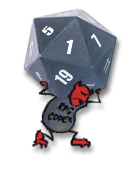







![The Year of Incline [2014] Codex 2014](/forums/smiles/campaign_tags/campaign_incline2014.png)
